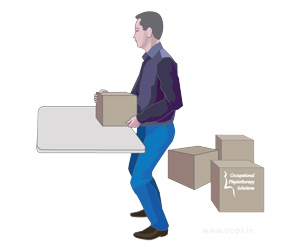Judicial guidance on Manual Handling Training and Management
 Two High Court judgments over the last two years provide clear guidance on manual handling, which employers and their safety advisors should note and implement in order to avoid liability in claims by employees. Both cases involved unloading trolleys where loads were stacked above head height in a retail store.
Two High Court judgments over the last two years provide clear guidance on manual handling, which employers and their safety advisors should note and implement in order to avoid liability in claims by employees. Both cases involved unloading trolleys where loads were stacked above head height in a retail store.
Case 1
The first case involves an accident which occurred in 2004 in Dunnes Stores Ltd and the case was adjudicated in the High Court in 2013.
Summary of Incident
- A trolley was stacked to approximately six feet high.
- A female employee, who was approximately 5 feet tall was required to unload the trolley.
- The employee did not know the weight of the boxes.
- They were estimated in court as being 9-10kgs in weight.
- The employee reached up above her head to the box to lift it down.
- She realised it was too heavy as she started to lower it.
- She called a colleague who was busy and could not assist.
- She lowered the box onto a table and twisted her back as she did this and sustained a back injury.
Main points of the Defence
- Employee was advised during MH training not to lift loads above head height,
- Employee was advised to check the weight of a load before lifting the load.
- Employee was advised to get assistance with heavy loads.
- Employee was advised to use a step ladder if loads are above head height.
- Employees were advised not to load trolleys above head height.
- Manager said he would have helped the employee if he had been there
Judgement
- Safety practices were not followed in the workplace
- Practices were at odds with training provided
- Step ladder would not have been any safer for lifting in this particular case.
- Ladder could have been used (if available) by employee to ascertain the weight of the load.
- Manager should not do something that is contrary to safe practice
- Video shown during training did not reflect reality i.e. lifting above head height was carried out by two men who were approximately six feet tall, whereas employee and colleague were approximately five feet tall in this case.
Employee was found 30% liable in this case as she should not have lifted a load without knowing the weight
Implications for training
- Training must reflect reality i.e. the loads that are actually handled by the employees must be used in training and preferably training should take place in the work area.
- Safe practices taught in training must be supervised in the workplace and enforced i.e. if employees are told not to load trolleys above head height then that should be enforced.
- Employees must be supervised to ensure that messages taught in training are translated into the workplace
- Managers and supervisors should not engage in unsafe practices
- Any equipment suggested must be safe to use i.e. it would not have been safe to use the step ladder in this case to lower the boxes from above head height.
Case 2
The second case involves an accident that occurred in 2007 in Dunnes Stores and the case was adjudicated in the High Court in 2014. This case involved unloading a trolley in a cluttered storeroom.
Summary of Incident
- The employee was required to lift boxes down from a high stack in a cluttered storeroom and load the boxes onto a trolley.
- The loads were stacked above head height.
- She reached up to the top box and let the boxes fall down on the ground. Then she lifted the boxes onto a trolley
- The back injury occurred when loading the second trolley
- There was a dispute about whether the employee had been provided with MH training at induction
Main Points of the Case
- Defence said the employee had been provided with a full days induction training that included MH training and signed a card which was a record of the training received
- The employee said she did not receive manual handling training on her induction day and that she signed a form that was presented to her to sign.
- The judge accepted her version of events.
- Training involved lifting a box of photocopying paper
- There were also some slides on MH and a MH DVD
- The judge said that even if the employee had received the training, that it was not adequate, as it did not reflect the reality of the workplace tasks.
- The employee was given a safety handbook in English which she said was difficult for her to read due to her poor English
- No follow up or supervision of manual handling practices in the workplace was provided
- No risk assessment of the task was available
Implications for training
- A task specific risk assessment must be carried out for manual handling tasks that are regularly carried out.
- Training must be relevant to the tasks actually carried out in the workplace
- Training must be delivered in a language that is understood by all
- Trainer must check that training is understood
- Employees must understand and know the content of any document they are asked to sign.
- There must be follow up and supervision in the workplace to ensure that techniques and practices taught in training are used in the workplace.
Summary of Case 1 and 2
- There is nothing new in either judgement
- For practical reasons organisations regularly have a number of employees from different work areas attend the same training session.
- This approach makes it difficult to provide task specific training for all groups at the training.
- The judgement indicated that training should be task specific to the group receiving the training and ideally in their work area
- The workplace should facilitate employees to put into practice the main messages provided at training
- Managers and supervisors have a significant role in ensuring that safe practices are carried out in their area of responsibility.
- Training must also be on going in the workplace and not just a single event at induction.
- The trainer must ensure that employees have understood the main messages delivered during training.
Appendix 3 in the HSA document ‘Guidance on the Manual Handling Training System-2010 Revision’ outlines many of the points made above and made by the judges in both cases.


